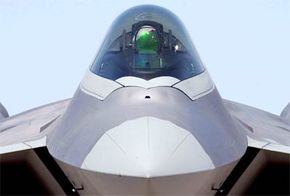Flying Video Game: In the Cockpit
In the F/A-22 computer screens display all information -- it's the first so-called "all-glass cockpit" in a tactical fighter. These digital displays have been common in commercial aircraft for years.
The cockpit is fitted with a hands-on throttle and stick control (HOTAS). This system allows the pilot to fly the plane without removing his or her hands from the flight controls. The F/A-22 also has the first cockpit system compatible with night vision goggles (NVG). A heads-up display (HUD) projects information in front of the pilot's view, showing target status, weapon status and cues that indicate if the weapons are locked on the target. The pilot inputs information for communications, autopilot and navigation in the integrated control panel (ICP) in the center top of the instrument panel.
Advertisement

The cockpit has six liquid crystal displays (LCDs). The primary display is an 8-inch by 8-inch (20.3x20.3-cm) LCD that provides a plan view of the air and ground tactical situation. This includes threat identity, threat priority and tracking information. Two smaller displays show communication, navigation, identification and flight information. Three secondary displays show air-threat, ground-threat and stores-management data.
The goal is to make it simple for the pilot to process all the information being displayed. The pilot can tell at a glance what the situation is: Enemy aircraft show up as red triangles; friendly aircraft are green circles; unknown aircraft are yellow squares; surface-to-air missiles are pentagons. To show that a pilot has a lock on the target, the red triangle becomes solid. The system is 98 percent accurate in determining the type of aircraft flying in range. If the system can't make identification, then the aircraft is shown as an unknown.
With all that technology onboard, the F/A-22s can create a wireless data link to share tactical information without talking about it on the radio. A pilot can know how much fuel and how many weapons a wingman is carrying while maintaining radio silence. Multiple flights of planes can link up to coordinate attacks because each plane can see which targets others have identified. The F/A-22 can also communicate with Airborne Warning & Control System (AWACS) aircraft and receive downloads from reconnaissance planes.
